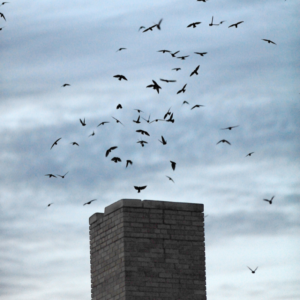You might not be the only one who thinks your fireplace is cozy. If you’ve noticed noises or bad smells from your chimney, it’s possible that you’re unknowingly providing a nesting spot for a family of chimney swifts.
What are they, and what can be done about them?
The solution will involve a bit of waiting – legally, the birds need to migrate out on their own. But thankfully, once the chimney swifts have left, we can restore your chimney to its proper function – and make improvements to prevent their future return.
Identifying Chimney Swifts
Chimney swifts are small, migratory birds that divide their time between North and South America. They’re recognizable by their distinctive silhouette – chimney swifts have a cigar shaped body with long, sloping wings, and a short, bristly tail.
 Chimney swifts also have a distinct style of flight, with their shallow wingstrokes and the ability to maneuver agilely over the landscape. It’s actually unlikely that you’ll ever see them holding still – they spend most of their lives and perform nearly all the business of life in flight. When they do hold still, chimney swifts can’t perch. Instead, they roost by clinging to rough, vertical surfaces such as hollow trees, cave walls, and – you guessed it – chimneys. They’ll also nest in these places, building nests on their roosting surfaces by bonding twigs and other nesting material with their concrete-like saliva.
Chimney swifts also have a distinct style of flight, with their shallow wingstrokes and the ability to maneuver agilely over the landscape. It’s actually unlikely that you’ll ever see them holding still – they spend most of their lives and perform nearly all the business of life in flight. When they do hold still, chimney swifts can’t perch. Instead, they roost by clinging to rough, vertical surfaces such as hollow trees, cave walls, and – you guessed it – chimneys. They’ll also nest in these places, building nests on their roosting surfaces by bonding twigs and other nesting material with their concrete-like saliva.
Can I Remove Swifts From My Chimney?
You may be wondering if you can rehome or chase away chimney swifts. In a word – no. This bird species is federally protected under the Migratory Bird Treaty Act. This means that it’s a matter of federal concern that chimney swifts be able to stay put in their home of choice during the nesting season.
So, here’s the big question…
When Will Chimney Swifts Leave My Chimney?
If you’ve become host to a family of chimney swifts, never fear. They aren’t creating a permanent residence. They arrive at their North American destinations in spring. After mating and nesting, a chimney swift will lay eggs – typically one to five – which will be incubated from 15-20 days. About a month after hatching, baby chimney swifts are ready to hunt and fly on their own, and they’re typically heading south for the winter in October.
If loud, high-pitched noise is what tipped you off to the presence of chimney swifts, know that the noisiest chimney swifts are babies, impatiently waiting to be fed during the last couple of weeks before leaving the nest. This means that if you’ve already noticed the racket, your swifts should be gone before too long.
While the birds, nests, and eggs cannot be removed, you can reduce the chance of exacerbating the issues they could cause. If you have a throat damper, be sure it is closed during the duration of their stay. This will keep the chimney swifts in the chimney and out of your living room!
An annual chimney inspection will help ensure that your damper is in good working order and able to keep these birds from entering your home.
They’re Gone – Now What?
Once the chimney swifts have left, act right away to get your chimney ready for its intended use before winter sets in.
 Chimney swifts will have left a mess behind, including nests, excrement, and feathers. Any type of build up in your chimney can be a health hazard, which is why calling us for a chimney inspection and sweep should be the first order of business after chimney swifts have nested there. Our experts will make sure everything is looking as it should, and can help remedy any undesirable aftereffects.
Chimney swifts will have left a mess behind, including nests, excrement, and feathers. Any type of build up in your chimney can be a health hazard, which is why calling us for a chimney inspection and sweep should be the first order of business after chimney swifts have nested there. Our experts will make sure everything is looking as it should, and can help remedy any undesirable aftereffects.
Don’t want your chimney to be an airbnb for critters later on down the line? Ask us about investing in a chimney cap!
A chimney cap helps keep things out – not only birds and animals, but also leaves, twigs, and water. Being proactive and capping your chimney will save you the sounds, smells, and headaches of having chimney swifts make a return visit. Your chimney cap will also be part of your defense against expensive water damage to your chimney, and it will prevent build up of other kinds as well.
A chimney cap helps keep things out – not only birds and animals, but also leaves, twigs, and water.
In short, this is a case where an ounce of prevention will be worth a pound of cure.
Call Us Today for Quality Care
Chimney swifts may be a nuisance, but they can be managed with appropriate action. If they’re already present, you’ll need to let them finish out their stay. But don’t delay in letting our professionals at English Sweep help you clean up after their departure.
We’re experts in chimney care, and we’ll be proud to serve you in keeping this key system in your home running optimally. Call 636-225-3340 or reach out online today.


Recent Comments